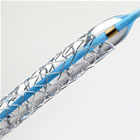|
The Resolute stent has been available in Europe for over three years; a version of the stent on Medtronic's latest Integrity platform received the CE Mark last summer (the Integrity bare metal stent was approved by the FDA in September). A Medtronic spokesperson told Angioplasty.Org that the company has submitted its complete package to the FDA and is hoping for approval in the first half of 2012 (there is a mandatory six month waiting period from the time of submission). During the same session at the ACC, Dr. Gregg W. Stone (Dr. Leon's colleague at Columbia University Medical Center/New York-Presbyterian Hospital) presented the results from Boston Scientific's PLATINUM Trial, which randomized 1,530 patients to either the current Promus stent (same as XIENCE V) or the new Promus Element™. The results were that the new Promus was "non-inferior" to the current version. The data from this trial were also sent to the FDA for approval which, according to Boston Scientific, they expect mid-2012. Current and Future Landscape for Drug-Eluting Stents
in the U.S.
The reason for the "range" of four to six DES is that the XIENCE V and the Promus are the same stent, manufactured by Abbott and marketed under two names, XIENCE V and Promus. This shared marketing was part of an agreement between Abbott and Boston Scientific, dating back to Boston Scientific's 2006 acquisition of Guidant, the original creator of the Xience V. Currently Boston Scientific pays Abbott 40% of its Promus revenues, but that agreement ends in June 2012. So, in order to compete in the second/third generation DES stent market, Boston Scientific needed to develop a new stent that could be approved in 2012. And they did. Called the Promus Element, the stent itself is made with an alloy made of Platinum Chromium, as opposed to the Cobalt Chromium alloy of the XIENCE V. But the Promus Element has the same polymer and the same drug (everolimus) as the current XIENCE V/Promus. And in its trial, created specifically for an FDA approval, the new Promus was judged "non-inferior" to the current Promus. Boston's other two stents, the Taxus Express2 and the Taxus Liberte, are also very similar to each other. The same drug, the same polymer, the same alloy, but slightly different metal stent platform design. Unfortunately, in some comparison trials, the newer Liberte has performed less well than the original Taxus, so again, many consider them to be essentially the same stent. New Alloy / New Polymer
And the results of lengthening the drug-elution period from 28 days with the Endeavor to 180 days with the Resolute were most definitely better, especially in diabetic patients, who tend to have higher-than-normal event rates. In the RESOLUTE US trial, 34% of the patients were diabetic (by comparison, Boston Scientific's PLATINUM trial has 23.5% diabetic patients). And the event rates were all below 5%. Narrower Stents / Low Stent Thrombosis
Rates The low ST rate in the U.S. trial was of comfort to clinicians, because the RESOLUTE All Comers trial, done in Europe and Israel, had a slightly higher-than-normal ST rate. Dr. Yeung offered an explanation for what he considered to be an aberration:
So changing the polymer and the elution rate seemed to cause a significant increase in efficacy for the new Medtronic stent, one that the company hopes will make significant inroads in the U.S. interventional cardiology market next year. The company pointed to two other items regarding the Resolute stent. New data will be presented at the upcoming EuroPCR meeting in May as a review of 2,000 diabetic patients from the total RESOLUTE program, which may serve to differentiate Medtronic's new stent from the rest of the field. The company also has approval in Europe for the Resolute on its very flexible and conformable "Integrity" platform, which has achieved a high rate of adoption. Since the bare metal version of the Integrity has already been approved in the U.S., it's hoped that the Resolute may be approved on that platform as well. While the earlier drug-eluting stents will no doubt be used less and less, by mid-2012 there will be hopefully be three new generation DES for clinicians to choose from: the current XIENCE V and, if approved, the Resolute and Promus Element -- all of which have shown event rates in the low single digits and very very low risks for stent thrombosis. Reported by Burt Cohen, April 9, 2011 |


